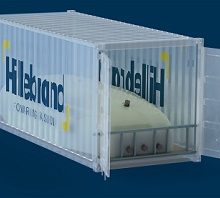
Mixing such transported goods back to its original state, in order to recover their full properties before discharging, used to be a challenging task. The company’s new patented technology ensures that any product that separates or solidifies during transportation reaches its destination in its original consistency.
During the course of transportation, high-density products, or those that tend to solidify, leave a sediment at the bottom of the container they are being carried in, while the liquid element remains on top. These products include, but are not limited to, paint slurry, drilling muds, vegetable oils or any type of oleochemical.
This state-of-the-art technology consists of introducing either air or the actual product being transported to circulate within two internal channels and agitating the separated particles, bringing them back to their original density in less than one hour. The distinct design prevents solid deposits adhering to the corners of the flexitank, while providing an ultimate pumpable viscosity. An appropriate steel bulkhead is adapted to the Pulse flexitank in order to protect it from putting too much pressure on the container doors, whilst allowing both doors to be open during the agitation process. Suitable for both road and sea transport, the efficiency of Hillebrand’s Pulse flexitank has been far and wide trialled and tested for months and successfully implemented at a global scale.
“Flexibility and complete product retrieval when developing the Pulse flexitank was key”, says Kevin Fry, Hillebrand’s bulk liquids technical development director, “our customers have the ability to safely choose the preferred method of aeration or agitation without having to enter the container”.
According to a live trial report, the Pulse flexitank produces ten times less residue than standard tanks after being agitated, “managing to discharge such challenging products without leaving a trace in the flexitank has given us the satisfaction of bringing a solution to an extended dilemma for both customers and logistics providers”, comments Fry. Pulse flexitanks are supplied with a variety of venting options tailored to specific commodities and needs.
